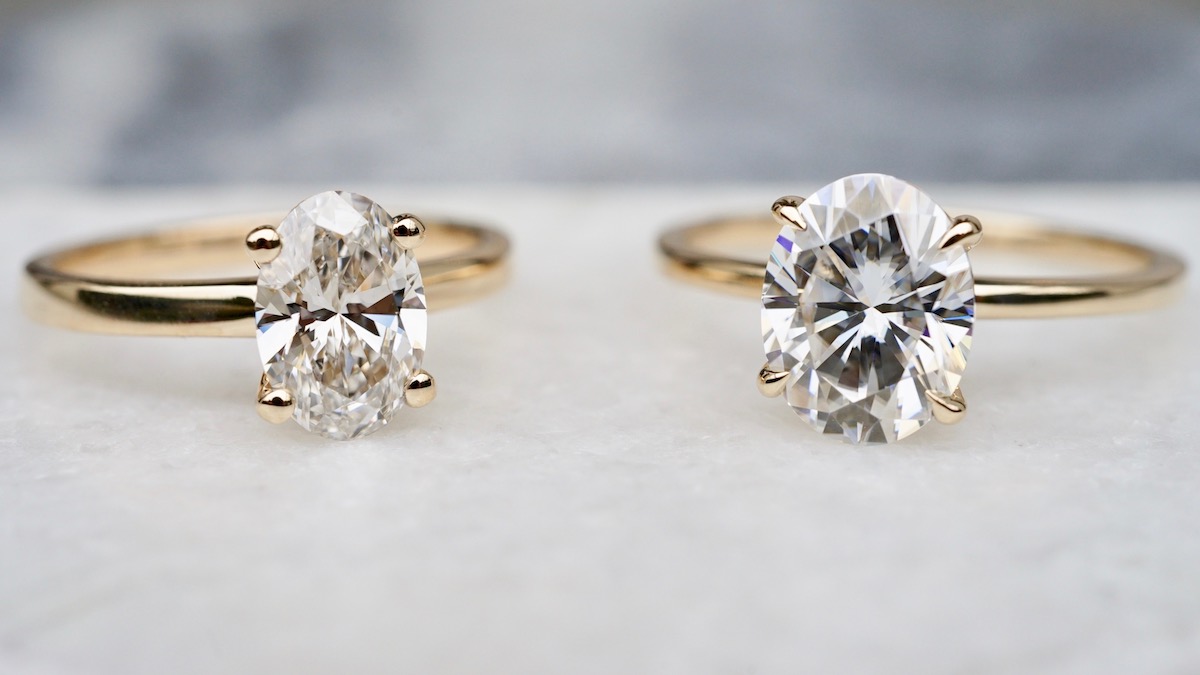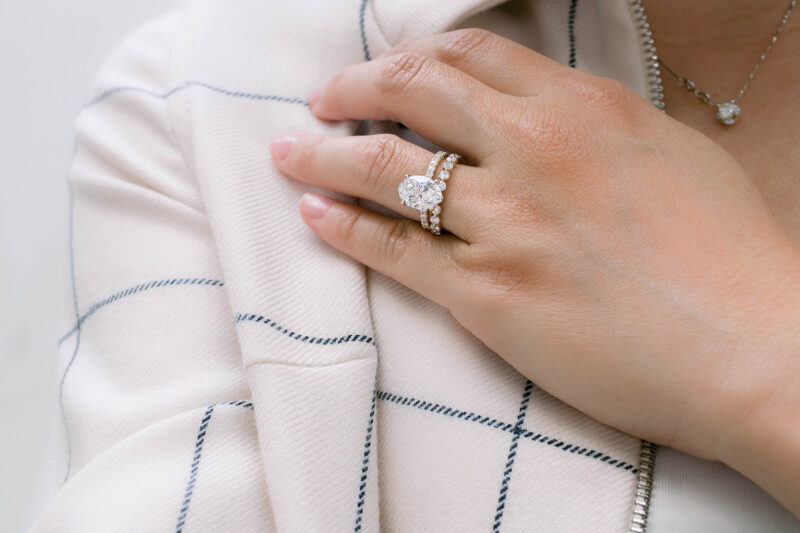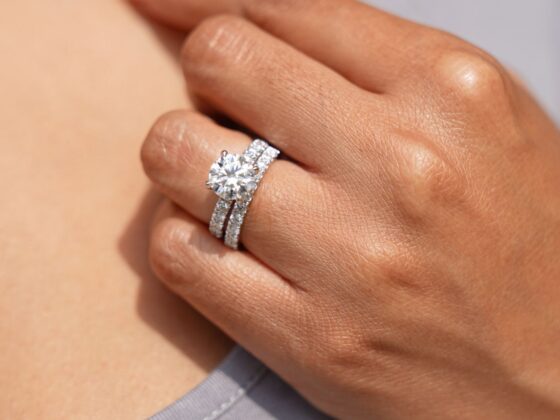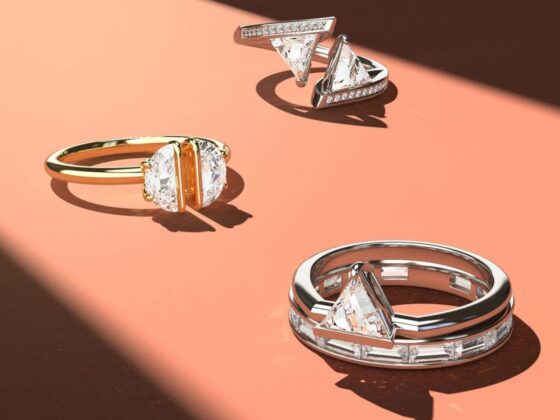Are you looking for the perfect stone shape for your engagement ring? Moissanite and lab-made diamond rings are two of the most popular options today. This guide will help you decide which one is right for you.
Learn about the unique characteristics of moissanite and lab-made diamonds, as well as their differences in price, durability, and more so that you can make an informed decision when choosing between them. With this comprehensive guide to choosing between lab-made diamond and moissanite engagement rings, you’ll be sure to find a beautiful stone that meets your needs!
Understanding the Difference Between Moissanite and Lab-Made Diamond Engagement Rings
When it comes to selecting an engagement ring, many couples are torn between the classic diamond and more modern moissanite and lab-made diamonds. Both have their own unique characteristics that make them appealing in different ways. Understanding the difference between these stones can help you determine which is right for your special occasion. Moissanite is a naturally occurring mineral created by nature, while lab-made diamonds are synthetic stones made through man-made processes.
Moissanite has a higher refractive index than natural diamonds, creating an intense sparkle that makes any ring stand out from the crowd. It also tends to be less expensive than its counterparts, making it ideal for those on a budget or who don’t want to pay top dollar for their stone of choice. On the other hand, lab-made diamonds offer superior clarity compared to natural diamonds and can often look indistinguishable from real ones at first glance – perfect for those looking for something truly special without breaking the bank!
The shape of each stone also plays an important role when considering which one will best suit your needs. Moissanite tends to come in round or cushion shapes with fewer facets than natural or lab-created diamond rings; this creates a softer overall feel that some people prefer over traditional diamond cuts such as princess or emerald cuts.
In contrast, lab-created diamonds can be found in almost every cut imaginable – giving you endless options when it comes down to personalizing your piece of jewelry! At the end of the day, it’s up to you (and your partner) to decide what type of stone fits with both your individual style and budget – understanding how moissanites and lab-created diamonds differ will go far in helping you make an informed decision about which option is right for you!
Pros and Cons of Choosing a Moissanite or Lab-Made Diamond Engagement Ring

When it comes to choosing an engagement ring, many couples are now turning toward moissanite and lab-made diamonds. While both offer a beautiful and unique stone shape, the two differ in important ways that can affect your decision on which is right for you and your partner. Before making a choice, consider the pros and cons of each option: Moissanite Pros: Moissanite offers excellent durability with its 8.5-9 rating on the Mohs scale of hardness; this makes moissanite resistant to cracking or scratching from everyday wear.
Additionally, due to its strong refractive index (2.65-2.69), moissanite has more sparkle than diamond – perfect for those who want their engagement ring to dazzle! Finally, unlike natural diamonds, moissanites are not mined from the earth; therefore they come at a lower cost compared to other stones such as ruby or sapphire so if budget is an issue then look no further! Moissanite Cons: For some people, color may be an issue with moissanites since they usually tend to have yellow undertones when compared with white gold or silver settings– although newer versions do have near colorless options too nowadays.
Also because of their higher dispersion rate (0.104 vs 0.044) they might appear in different colors depending on what kind of light source youre looking at them in – something worth considering before purchasing one! Lab-Made Diamond Pros: Lab-made diamonds provide all the beauty of natural diamonds without any environmental impact or human rights issues associated with traditional mining operations – making them highly ethical choices when selecting an engagement ring stone!
How to Choose the Perfect Stone Shape for Your Moissanite or Lab-Made Diamond Engagement Ring
When choosing the perfect stone shape for your moissanite or lab-made diamond engagement ring, there are several factors to consider. First and foremost, you need to consider the design aesthetic that youre aiming for. If a traditional look is what you’re going for, then classic shapes such as round, princess cut and cushion cut may be right up your alley.
On the other hand if modernity is more your style then go with trendy cuts like oval and pear shaped stones. Secondly, you should think about how well the shape of the stone suits your finger size and overall body type; some shapes can accentuate certain features while others may not flatter them quite so well – it all depends on personal preference!
Finally, dont forget to factor in cost: depending on the complexity of a particular shapes cutting process, prices can vary greatly from one shape to another. With these three points in mind it should be easy to decide which shape will best suit both your budget and desired aesthetic when selecting moissanite or lab-made diamond engagement rings!
An Overview of Popular Stone Shapes for Moissanite and Lab-Made Diamond Engagement Rings

When it comes to selecting an engagement stone, couples often choose between moissanite and lab-made diamonds. Both of these options offer a wide array of shapes that can be tailored to any style or budget. Some of the most popular shapes for moissanite and lab-made diamond engagement rings include round, cushion, pear, princess, radiant and emerald cuts. The round cut is the most classic option: its circular shape allows light to be dispersed evenly throughout the gemstone creating a sparkling halo effect.
The cushion cut has rounded edges which gives it a vintage feel while still maintaining a modern look. The pear shaped stones are ideal for those who like something unique; their tapered point adds an interesting twist on traditional designs. Princess-cut stones provide maximum brilliance with sharp corners making them more angular than other designs yet no less captivating. Radiant cuts reflect light in many directions giving off ray bursts similar to disco balls!
Finally, emerald cuts feature stepped facets which allow for ample reflection and create mesmerizing sparkle as well as emphasize clarity within the stone itself. No matter what type of stone you choose – whether its moissanite or lab-made diamond – there are plenty of perfect shapes out there waiting to become part your special day! From timeless classics like round and princess cuts all the way through to more contemporary styles such as radiant and emeralds – there’s something for everyone when it comes to choosing an engagement ring design with either option!
Expert Tips on Choosing between a Moissanite and a Lab-Made Diamond Engagement Ring
When it comes to choosing an engagement ring for your special someone, many couples find themselves torn between a Moissanite and a lab-made diamond. There are several factors to consider when selecting the perfect stone shape. To help you make the right choice, here are some expert tips: Firstly, consider the brilliance of each gemstone. Diamonds tend to have more sparkle than Moissanites due in part to their higher refractive index. That said, Moissanites boast more fire or flashes of rainbow colors compared with diamonds which may be desirable depending on your preference.
Next, evaluate durability and cost effectiveness as both gems will offer different levels of hardness and price points respectively. For example, Mohs scale assigns diamonds with a score of 10 which is the highest rating for any natural mineral whereas Moissanites rank at 9 ½ so they can withstand everyday wear and tear fairly well but not quite as much as diamonds do. Furthermore, lab-made diamonds may be slightly cheaper than its naturally sourced counterpart though both remain valuable investments that should last generations if properly cared for over time with regular cleanings from professional jewelers being highly recommended regardless of which stone type you choose.



